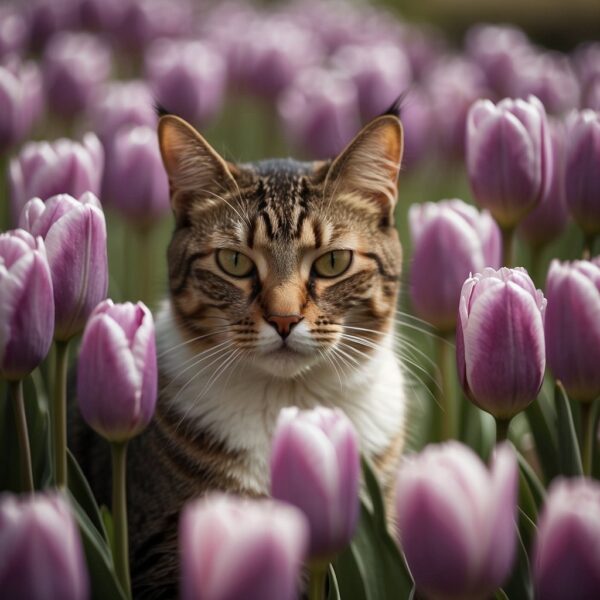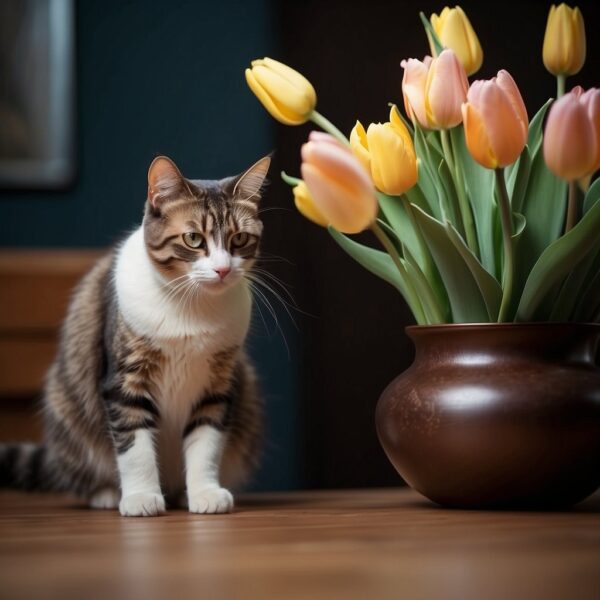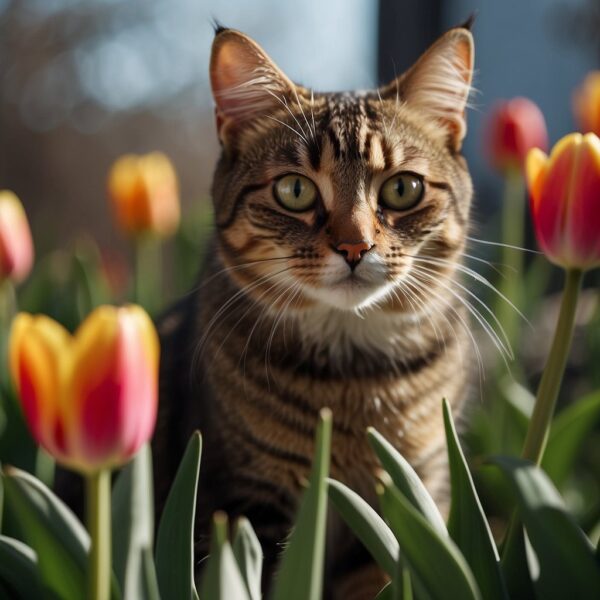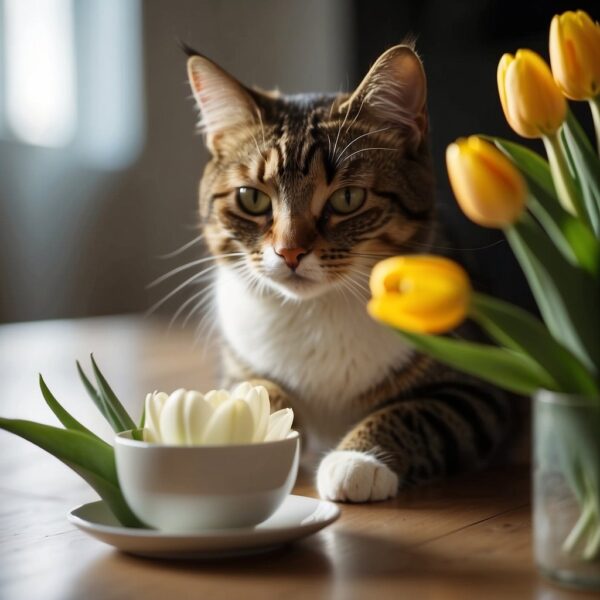
Tulips are Toxic To Cats: A Safety Guide
Tulips are poisonous to cats and cat parents must be vigilant. Tulips, belonging to the genus Tulipa and part of the lily family, possess compounds that can be harmful to feline health. The primary toxic agents found in tulips are tulipalin A and B, which can pose risks to cats when ingested. While the entire tulip plant contains these compounds, the bulb is particularly dangerous due to a higher concentration of toxins.
Cats that come into contact with or ingest tulips may exhibit a range of symptoms indicating poisoning. These signs can include vomiting, diarrhea, hypersalivation, and depression. Immediate identification of these symptoms is crucial, as they can escalate to more severe conditions affecting the respiratory and cardiac systems. Cat parents should therefore be vigilant and ensure that tulips are kept out of reach from their cats, and be prepared to take swift action if exposure is suspected.
Key Takeaways
- Tulips contain toxic substances that can harm cats if ingested.
- Symptoms of tulip poisoning in cats include vomiting, diarrhea, and lethargy.
- Keeping tulips away from cats and seeking prompt veterinary care if ingestion occurs are essential for their safety.

Understanding Tulip Toxicity to cats
Tulips are popular flowers known for their vibrant colors and aesthetic appeal, but for cat parents, the beauty of tulips comes with a significant risk. The reason tulips are poisonous to cats is primarily due to compounds known as tulipalins, which are found throughout the plant but are most concentrated in the bulb.
Toxic Components in Tulips
Tulips contain several toxic compounds that are poisonous to cats, the most noteworthy of which are tulipalin A and tulipalin B. These compounds belong to a group known as glycosides, which can cause harmful effects if ingested.
- Tulipalin A: Found in tulip bulbs, this is a major toxic agent causing irritation and tissue damage.
- Tulipalin B: Similar to tulipalin A, this compound is also concentrated in the bulb and can cause similar toxic reactions.
Mechanism of Tulip Poisoning
When a cat ingests parts of a tulip, the tulipalin compounds are released. These glycosides can cause tulip poisoning which generally leads to the following:
- Irritation: Contact with tulipalin causes intense irritation to the tissues, including the oral cavity and gastrointestinal tract.
- Symptoms: This irritation often results in vomiting, diarrhea, and hypersalivation, which are common signs of tulip poisoning in cats.
The severity of symptoms can vary based on the amount of tulip plant material ingested and the specific part of the plant the cat has consumed, with the bulb being the most dangerous.
Common Symptoms of Tulip Poisoning in cats
When a cat ingests tulip plants, they may exhibit a range of symptoms due to the toxins present in the plant parts, particularly the bulbs. These symptoms are generally categorized into gastrointestinal, neurological, and cardiac issues.
Gastrointestinal Symptoms
Cats affected by tulip poisoning can display several gastrointestinal symptoms, which are often the first signs of toxicity. The ingestion of tulip plant material, especially the bulbs, can lead to:
- Vomiting: An effort to expel the toxins from the stomach.
- Diarrhea: May occur as the toxins irritate the gastrointestinal tract.
- Salivation: Excessive drooling is common due to mouth irritation.
Neurological Symptoms
Neurological symptoms can vary in severity, depending on the amount of tulip plant matter ingested by the cat:
- Lethargy: Cats might seem unusually tired or unresponsive.
- Weakness: There can be a general loss of strength or coordination.
- Tremors: In more severe cases, affected cats may experience trembling.
Cardiac Symptoms
Cardiac symptoms are less common but can arise in severe cases of tulip poisoning:
- Tachycardia: This is characterized by an increased heart rate.
- Cardiac arrhythmias: Irregular heartbeats may occur in response to the toxins.
It is important to observe cats closely if they have been near tulips and seek veterinary assistance if these symptoms appear.

Prevention and Safety Measures
Ensuring the safety of pets around plants is crucial, especially when dealing with varieties that are toxic to animals. Prevention strategies involve secure gardening practices and pet-proofing indoor plants to eliminate the risk of pets, particularly cats and dogs, ingesting harmful substances.
Secure Gardening Practices
When cultivating a garden, cat parents should prioritize the creation of a safe environment.
- Fencing: Install secure fencing to prevent pets from accessing areas with toxic plants.
- Plant Selection: Choose pet-friendly plants for the garden. Avoid toxic species like sago palm and oleander.
- Supervision: Always supervise pets in the garden to prevent them from nibbling on plants.
Such measures deter pets from coming into contact with, and potentially ingesting, toxic plants.
Cat-Proofing Indoor Plants
Protecting pets from indoor plants requires attention to detail and consistency.
- Elevate Plants: Keep tulips and other toxic plants on high shelves or in rooms that are inaccessible to pets.
- Plant Substitutes: Consider replacing toxic plants with non-toxic alternatives.
- Training: Teach pets, especially cats who might be attracted to nibble on plants, to avoid them.
Cat parents should also be aware of signs of allergic reactions or poisoning, which can include vomiting or depression, and should contact a veterinarian immediately if they suspect their cat has ingested a toxic plant.
Immediate Actions and First Aid
Tulips are poisonous to cats. If a cat ingests tulips, they may exhibit symptoms such as vomiting and excessive salivation. Quick and proper first aid can be critical until veterinary care is provided.
When to Contact a Veterinarian
- Immediate Veterinary Contact: If there are visible signs of distress such as persistent vomiting, difficulty breathing, or increased salivation, contact a local veterinarian or pet poison helpline immediately.
- Observing Symptoms: Even in the absence of immediate symptoms, it’s prudent to contact a veterinarian as some signs may take time to appear.
Initial Steps at Home after cat eats tulips
- Prevent Further Ingestion: Remove any remaining tulip parts from the cat’s reach to prevent more ingestion.
- Inducing Vomiting: Do not attempt to induce vomiting at home unless instructed by a veterinarian.
- Activated Charcoal: Administering activated charcoal may be recommended by a veterinarian to prevent further absorption of toxins.
- Rest: Keep the cat calm and in a safe, comfortable space to rest until veterinary advice or assistance is available.

Professional Veterinary Treatment
When a cat presents with symptoms of tulip poisoning, it is essential to seek professional veterinary treatment immediately for accurate diagnosis and management.
Diagnosis of Tulip Poisoning in cats
A veterinarian will first obtain a comprehensive clinical history, focusing on potential exposure to tulips. Clinical signs of tulip poisoning in cats commonly include vomiting, depression, and diarrhea. These manifestations are due to the toxic compounds tulipalin A and B found in the plant. To confirm tulip poisoning, the veterinarian may perform various diagnostic tests including:
- Bloodwork: Assessment of renal and liver function.
- Urinalysis: For evaluation of kidney health.
- Imaging studies: Such as radiographs or ultrasound to rule out other causes of the symptoms.
Therapeutic Interventions
Once a diagnosis of tulip poisoning has been made, the veterinarian will initiate treatment, which may involve:
- Gastric lavage: To remove undigested plant material from the stomach.
- Fluid therapy: Administered via an IV catheter to help flush the toxin from the system and maintain hydration.
- Oxygen therapy: If there are signs of respiratory distress.
- Supportive care: Such as antiemetics for vomiting and medication for diarrhea.
Ongoing monitoring for complications is crucial. For all cases of suspected pet poisoning, the ASPCA Animal Poison Control can also be a valuable resource for both pet owners and veterinarians.
Long-Term Health Considerations
Tulips are poisonous to cats. When a cat has been poisoned by tulips, long-term health considerations focus primarily on thorough recovery and the prevention of future incidents. It’s crucial for the parent to monitor their cat’s recovery progress and take proactive steps to ensure the cat is not exposed to tulips again.
Tulip Poisoning Recovery and Monitoring
Post-exposure to tulip poisoning, cats must be closely supervised during their recovery period to avoid any long-term complications. Veterinarians often emphasize the importance of rest and a stress-free environment to aid in the healing process. Parents should be vigilant for signs of lingering effects, such as:
- Persistent vomiting or diarrhea
- Signs of depression or changes in behavior
- Any difficulty with breathing
Immediate consultation with a veterinarian is advised if any of these symptoms persist, as they may indicate a more serious underlying issue.
Preventing Recurrence
To ensure cats do not suffer from tulip poisoning a second time, parents should take preventative measures:
- Remove Access to Tulips:
- Survey the home and garden to remove any existing tulips.
- Educate Household Members:
- Inform family members and visitors about the dangers of tulips to cats.
- Consult Relevant Resources:
- Reference materials from reputable organizations, such as the ASPCA, provide extensive lists of plants toxic to cats.
Adapting these preventative steps goes a long way in ensuring the safety and long-term health of cats after a tulip poisoning event.

Frequently Asked Questions
Tulips are poisonous to cats. Tulip poisoning in cats can lead to a variety of symptoms, and it’s essential for cat parent to recognize these as well as understand immediate actions to take.
What are the symptoms of tulip poisoning in cats?
The symptoms of tulip poisoning in cats include vomiting, diarrhea, excessive drooling, loss of coordination, and lethargy. In severe cases, difficulty breathing and cardiac issues may arise.
What should I do if my cat ingests part of a tulip plant?
If a cat ingests any part of a tulip plant, immediate veterinary assistance is crucial. A vet may induce vomiting or provide activated charcoal to prevent further absorption of the toxins.
Can tulips cause skin irritation in cats upon contact?
Yes, tulips can cause skin irritation in cats upon contact. The allergenic compounds in tulips known as tulipalins can result in dermatitis if a cat’s skin is exposed to the plant.
What flowers are most toxic to cats?
Lilies, hyacinths, and oleander are among the most toxic flowers to cats, with lilies being particularly dangerous due to their potentially life-threatening effects on a cat’s renal system.
Is it safe for cats to be in the same room as tulips?
It is not safe for cats to be in the same room as tulips, especially if the cat has a tendency to nibble on plants. Even small amounts ingested can result in toxicity. Remember tulips are poisonous to cats.
How does tulip toxicity compare between cats and dogs?
Tulip toxicity is generally more severe in cats than in dogs. Cats are more susceptible to the toxins present in tulips, while dogs may experience milder symptoms in comparison. However, tulips should still be considered dangerous for both cats and dogs.